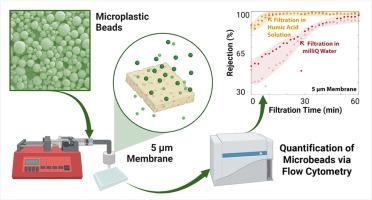使用流式细胞仪量化膜过滤过程中的微塑料颗粒的策略。
IF 8.1
2区 环境科学与生态学
Q1 ENVIRONMENTAL SCIENCES
引用次数: 0
摘要
微塑料(MP)污染在水生环境中无处不在,大量的 MP 来自城市污水处理厂。目前正在努力评估和实施微塑料去除工艺,膜技术通常被推荐为 "理想 "的解决方案。评估这些技术的一个关键挑战是如何有效地量化样本中的 MP 浓度。在此,流式细胞仪(FC)被证明是一种有效的技术,可用于测量悬浮在添加/不添加腐植酸的水中的塑料微珠(MBs;1-5 μm)的浓度。无论溶液条件如何,都可以通过 FC 方便地量化 MB 的浓度。随后,两个微滤膜对这些悬浮液进行了挑战。通过 FC 测量,0.45 μm 的微滤膜能有效阻隔甲基溴(>99%),而 5 μm 的微滤膜的阻隔率范围很广(从 40% 到 >95%),这取决于溶液条件和过滤时间。最后,利用 FC 正向光散射强度测量值建立了一个模型,以估计样品中甲基溴的大小。利用该模型,在过滤悬浮在腐殖酸溶液中的甲基溴时,5 μm 膜上的甲基溴中位尺寸平均减少了 33%,这证实了较小颗粒的优先渗透性。总之,这项研究推动了甲基溴定量技术的发展,从而验证了去除过程。本文章由计算机程序翻译,如有差异,请以英文原文为准。

A strategy for quantifying microplastic particles in membrane filtration processes using flow cytometry
Microplastic (MP) pollution is ubiquitous in the aquatic environment, with significant quantities of MPs originating from municipal wastewater treatment plants. Efforts to evaluate and implement MP removal processes are underway, with membrane technologies often recommended as an “ideal” solution. A key challenge in evaluating these technologies involves efficiently quantifying MP concentrations in samples. Here, flow cytometry (FC) is demonstrated as an effective technique to obtain concentration measurements of plastic microbeads (MBs; 1–5 μm) suspended in water with/without added humic acid. Regardless of solution conditions, MB concentrations were easily quantified via FC. Subsequently, two microfiltration membranes were challenged to these suspensions. As measured via FC, the 0.45 μm membrane demonstrated effective MB rejection (>99%) whereas the 5 μm membrane exhibited a broad range of rejections (40% to >95%) depending on solution conditions and filtration time. Finally, a model was formulated utilizing FC forward light scattering intensity measurements to estimate MB sizes in samples. Using the model, a 33% reduction in median MB size, on average, was noted across the 5 μm membrane when filtering MBs suspended in humic acid solution, affirming a preferential permeation of smaller particles. Overall, this study advances MP quantification techniques towards validating removal processes.
求助全文
通过发布文献求助,成功后即可免费获取论文全文。
去求助
来源期刊

Chemosphere
环境科学-环境科学
CiteScore
15.80
自引率
8.00%
发文量
4975
审稿时长
3.4 months
期刊介绍:
Chemosphere, being an international multidisciplinary journal, is dedicated to publishing original communications and review articles on chemicals in the environment. The scope covers a wide range of topics, including the identification, quantification, behavior, fate, toxicology, treatment, and remediation of chemicals in the bio-, hydro-, litho-, and atmosphere, ensuring the broad dissemination of research in this field.
 求助内容:
求助内容: 应助结果提醒方式:
应助结果提醒方式:


